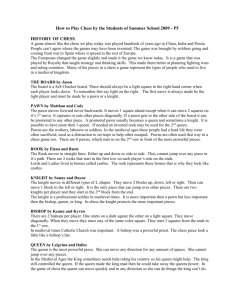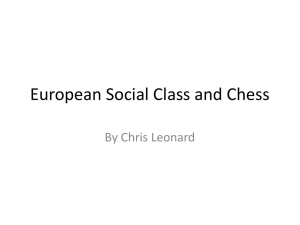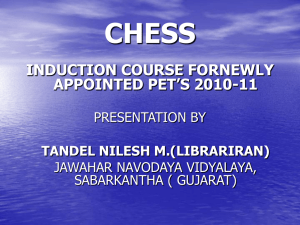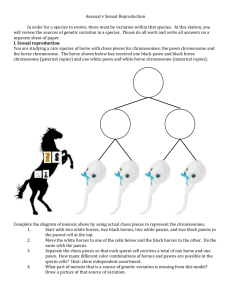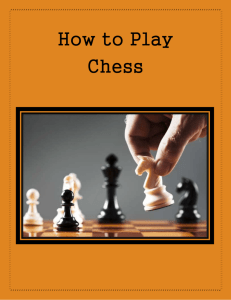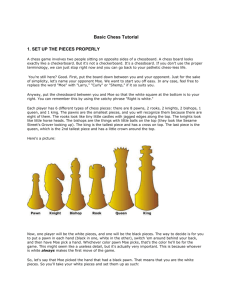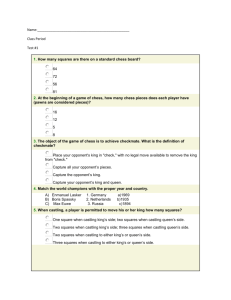The dynamic centre and pawn thrusts
advertisement
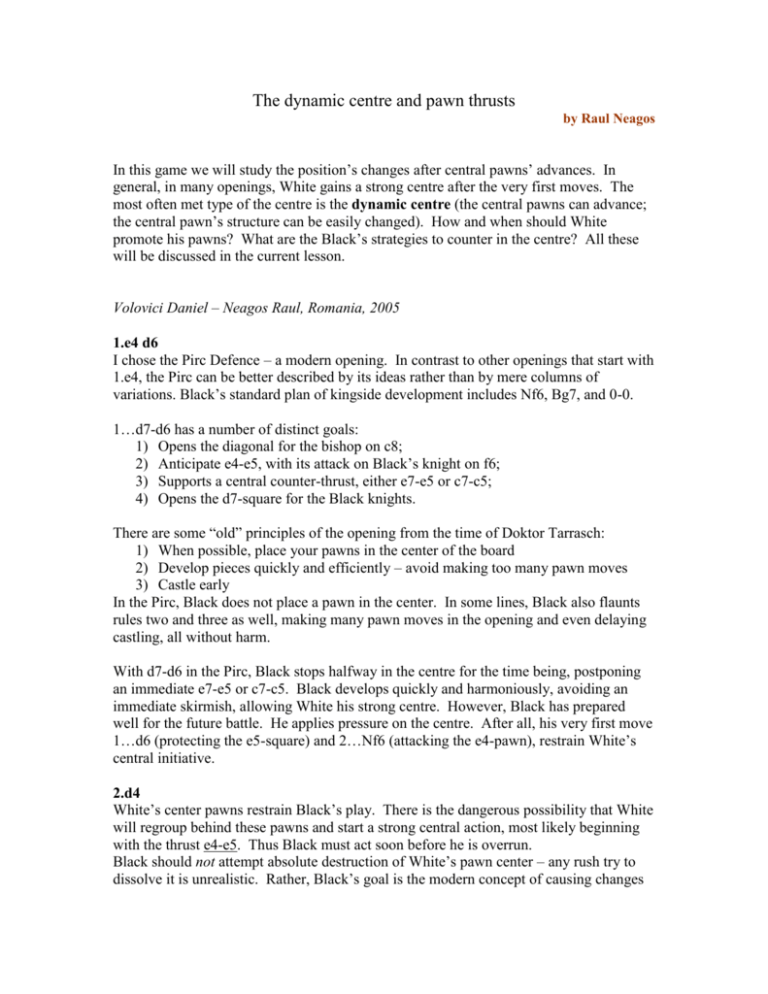
The dynamic centre and pawn thrusts by Raul Neagos In this game we will study the position’s changes after central pawns’ advances. In general, in many openings, White gains a strong centre after the very first moves. The most often met type of the centre is the dynamic centre (the central pawns can advance; the central pawn’s structure can be easily changed). How and when should White promote his pawns? What are the Black’s strategies to counter in the centre? All these will be discussed in the current lesson. Volovici Daniel – Neagos Raul, Romania, 2005 1.e4 d6 I chose the Pirc Defence – a modern opening. In contrast to other openings that start with 1.e4, the Pirc can be better described by its ideas rather than by mere columns of variations. Black’s standard plan of kingside development includes Nf6, Bg7, and 0-0. 1…d7-d6 has a number of distinct goals: 1) Opens the diagonal for the bishop on c8; 2) Anticipate e4-e5, with its attack on Black’s knight on f6; 3) Supports a central counter-thrust, either e7-e5 or c7-c5; 4) Opens the d7-square for the Black knights. There are some “old” principles of the opening from the time of Doktor Tarrasch: 1) When possible, place your pawns in the center of the board 2) Develop pieces quickly and efficiently – avoid making too many pawn moves 3) Castle early In the Pirc, Black does not place a pawn in the center. In some lines, Black also flaunts rules two and three as well, making many pawn moves in the opening and even delaying castling, all without harm. With d7-d6 in the Pirc, Black stops halfway in the centre for the time being, postponing an immediate e7-e5 or c7-c5. Black develops quickly and harmoniously, avoiding an immediate skirmish, allowing White his strong centre. However, Black has prepared well for the future battle. He applies pressure on the centre. After all, his very first move 1…d6 (protecting the e5-square) and 2…Nf6 (attacking the e4-pawn), restrain White’s central initiative. 2.d4 White’s center pawns restrain Black’s play. There is the dangerous possibility that White will regroup behind these pawns and start a strong central action, most likely beginning with the thrust e4-e5. Thus Black must act soon before he is overrun. Black should not attempt absolute destruction of White’s pawn center – any rush try to dissolve it is unrealistic. Rather, Black’s goal is the modern concept of causing changes in the centre that favor him. Since a pawn center is most powerful when the two center pawns stand abreast on e4 and d4, sometimes augmented by a colleague on f4, Black’s immediate task is to eliminate one of White’s two proud center pawns, or at least force one to move. Therefore, Black should push his e- or c-pawn to e5 or c5, attacking White’s d-pawn. 2…Nf6 3.Nc3 g6 4.f4 With this move, White threatens to create a powerful center, intending e4-e5, which would be supported by two pawns, f4 and d4. Also, White can avoid trading queens after d6xe5 by capturing on e5 with his f4-pawn. This system is called Austrian Attack. The appearance of the third White pawn on the fourth rank puts a question to Black: What should he do about the dangerous threat e4-e5? Let’s first examine, in general, the possible consequences of this pawn advance. After a future White e4-e5, Black has two possible reactions: to retreat with the knight after exchanging on e5, or to retreat right away, without exchanging the pawns. In the first case (after dxe5), White responds by recapturing on e5 with either f-pawn or his d-pawn. Each recapture is dangerous for Black in its own way. By recapturing with the d-pawn (after White has played Bd3 avoiding the queens exchange), White plays for the long-term containment of the bishop on g7. By playing f4xe5, White maintains the pawn-chain d4-e5. If ignored, this pawn chain leads to various kingside attacks, sometimes aided by the presence of the half-opened f-file, against Black. We will see further how Black should act. 4…Bg7 The black fianchettoed bishop is a stalwart piece that can be used either for defense or offence. Anyway, the importance of this piece is not supreme. In some openings, pawn structures take shape quickly. In the Pirc, however, the character of play is initially uncertain. In the French Defence (1.e4 e6), it is instantly clear that the c8-bishop’s role is rather minimal, and that it would be useful to trade it for the opponent’s light-square bishop. But in the Pirc, the future of dark-square bishop is unsure for some time. 5.Nf3 After 5.e5 Nfd7, White should develop further with 6.Nf3 entering the normal lines, by transposition. 5…0-0 6.Be2?! Better is 6.Bd3 defending the e4-central pawn. 6…c5 This is the key of Black’s play against the White’s centre. In general, when Black can play this move in the Pirc in favorable circumstances, he will have an easy game. Now, we will look at White’s responses. I. First, we will look at the ideas after White captures the black challenger with d4xc5. II. Then we will examine White’s option of pushing past the challenge with d4-d5 III. Next, we will focus on ideas that come up when White keeps his pawn on d4, leaving it up to Black to make the exchange IV. We will finish with White trying an immediate e4-e5, like in this game. I) 7.dxc5. Now if Black plays: 7…dxc5?, White will remain with the strong f- and e- pawns, without a possibility of Black to counterattack them. Besides this, it must say again that Black will also have the g7-bishop imprisoned (after e4-e5). Moreover, the weak b5- and d5- squares resulting from the c-pawn’s advance to c5 (it is important to note that the collision would not be total if Black’s pawn still stood on c7, so that he could play c7-c6 to guard b5 and d5. the position after 7.dxc5 dxc5 7.dxc5 Qa5 followed by Qxc5 However, to counter 7.dxc5, Black has the response 7…Qa5! entering a favorable Sicilian system, Dragon. Black threatens Nxe4 (destroying White’s central pawns and menacing Nxc3). White must castle, 8.0-0, protecting his e4-pawn. After 8…Qxc5+ Black has a good play using the c-file and now the strong g7-bishop. You must notice that the White’s central pawns (e4 and f4) are well stopped by the d6-pawn. II) 7.d5 White is not forced to capture on c5; he can push past the challenge with d4-d5. It would be very useful for Black to get in b7-b5 in order to strengthen his influence on the queenside and to weaken the position of White’s knight on c3 by threatening b5-b4. However, White controls b5 with both his c3-knight and his light-square bishop. The insertion of the moves a7-a6 and a2-a4 creates additional difficulties for Black because White’s rook on a1 becomes involved, even if indirectly, in the fight for the b5-square. Thus, in order to play b7-b5, Black often needs to perform cumbersome maneuvers such as: Na6-c7, Rb8, b6 (preventing a4-a5), a6, and –finally- b7-b5. Only after all those machinations can the pawn take its position on b5. after d4-d5, Black plans to play b5 Black plays directly b5, using the tactical resources Black could play now (after 7.d5) 7…b5!? because after 8.Nxb5? Nxe4, or 8.Bxb5?! Nxe4! 9.Nxe4 Qa5+ 10.Nc3 Bxc3+ 11.Bxc3 Qxb5 he has a good position in both cases. Often the tactical operations can lead to important strategic consequences. However, after 7.d5 b5, White has a strong reply in 8.e5! getting rid of the pressure on e4. The position will become unclear after: 8…dxe5 9.fxe5 Ng4! 10.Nxb5 Nxe5. The other thematic continuation, e7-e6, can be used to exploit the relative vulnerability of the d5-square because this square is not supported by the c4-pawn (blocked by the knight on c3). This central counterattack is good for Black right now (7.d5 e6). If 8.0-0 exd5, White does not have the reply c4xd5, neither 9.Nxd5 because of 9…Nxe4. e6xd5 e4xd5 is not good for White. d5xe6 – f7xe6 or Bxe6 with idea d6-d5 Thus, the threat e6xd5 motivates White to trade on e6 with 8.dxe6. After Black 8…Bxe6, the position is relative simple. Black has a backward d6-pawn, so he can equalize only after d6-d5, which here can be accomplished. If Black recaptures on e6 with his f-pawn (8…fxe6), then d6-d5 seems stronger. However, after 8…fxe6 White can advance 9.e5 launching an attack against Black’s kingside, which is weakened by the absence of the f7-pawn. It must say again that if Black cannot or chooses not to play d6d5, it is hard for him to hold the centre in view of his weak d6-pawn. Also, keep in mind that in structures with Black’s pawns on d6 and e6, White also has a possible break with e4-e5. After it is played, Black’s e6-pawn is isolated. White is not ready in this position for such aggressive action in the center or on the kingside, so 7…e6 break is quite an effective weapon against White’s centre now. In the position from this game, if White plays d5, we can choose between these three thematic attacks on the center (the prepared b7-b5, the direct b7-b5, and e7-e6). But, often, just one of them is possible. III) White leaves his pawn on d4. If White’s ignore c7-c5, Black usually eliminates the object of attack immediately by playing c5xd4, achieving a favorable pawn structure, called Dragon (a Sicilian’s system). Black’s position is very good due the good pawn structure, the open c-file, and the active g7-bishop. There is still a dynamic centre but more favorable to Black. IV) White pushes his pawn to e5. There are some important differences between this position and the previous variations we have looked at until now. First of all, with the pawns in such close contact, White’s pawn centre can dissolve quickly with c5xd4 and d6xe5. But, at the moment, the f6knight is attacked, and the question is – can White gain something if he succeeds in forcing the knight from f6? It is preferable for Black not to trade the pawn on e5 immediately in order to maintain tension and continue threatening all White’s central pawns. Besides, the exchange d6xe5 – d4xe5 leads to a position not good for Black. So, Black knight prefers to retreat to d7. The resulting pawn exchanges dissolve White’s center. 7.e5 White’s pawn on e5 not only displaces Black’s knight on f6, but also restricts the activity of his bishop on g7. If Black is slow to act against the e-pawn, then later it can be used as a platform for a White attack. A well supported White pawn on e5 blocks Black’s fianchettoed bishop, which in fact can be even worse off than the so-called classically “bad” bishop, restricted by its own pawns. Anyway, here White has no enough resources to sustain this pawn. 7…Nfd7 The d7-square is best for the knight., since from here Black threatens to destroy White’s centre. The other knight can go comfortably to c6. Now, the c8-bishop is temporarily blocked and its control over the e6-square is lost. In some variations the e5-e6 pawn sacrifice is effective, but here White would only loose a central pawn. 8.Be3 White’s position seems very good at first sight with all the minor pieces developed and with a strong centre. In the meantime, Black has the entire queenside undeveloped. QUIZ Find Black’s best move 8…cxd4 Of course! Eliminating the main defender of the e5-pawn, Black is going to destroy the White’s centre. Wrong is 8…dxe5 9.dxe5! and Black has just got a cramped position. 9.Bxd4 9.Nxd4 or 9.Qxd4 loose the e5-pawn. 9…Nc6 The other knight comes directly into the first line of the battlefield, attacking both the bishop on d5 and the e5-pawn. 10.exd6 Forced. Now, White’s pawn-centre does not exist anymore! 10…Nxd4 In an open position, Black gains both the bishop-pair and force for his dark-square bishop. Without that bishop, White will have big problems on the dark squares. 11.Nxd4 e5 Black opens the position. Now, the rest of White’s strong centre (the d6-pawn) has no more importance. More important is to open the lines since white king is still in the centre. 12.fxe5 Nxe5 Black knight arrives in a supreme position in the centre of the board. White has many problems, but the biggest one is his king. After the destruction of the centre, White is in a mate danger. 13.Qd2 White wants to castle long looking for complications. A good strategy in worse positions. After the normal 13.0-0, Black plays 13…Qxd6, followed by Qc5 and Rd8, sending away the d4-knight. After this, the Black’s bishop-pair and the advantage of the position of his pieces would not give White any chance. QUIZ Find Black’s move. 13…Ng4! Suddenly, White is finding himself in the impossibility to castle on any flank. With the open e-file towards his king, we can say that the end is no far away. 14.Ndb5 14.0-0? Qxd6 (with double attack on h2 and d4-knight) 15.Nf3 Qb6+ (where is the white dark-square bishop?) and Nf2+. 14.0-0-0?? Bh6! (where is the white dark-square bishop?) 14…Qb6 Improving queen’s position, giving more power versus the very weak white dark squares, and menacing to enter f2. 15.h3? Lead to a quick lost, but White was hopeless anyway. 15…Qf2+ 16.Kd1 Bh6 17.Qd3 Ne3+ 18.Kc1 Bf5 19.Ne4 Bxe4 and White resigned. 0-1 CONCLUSIONS: In this game, we have studied the pawn thrusts in a dynamic centre; the most often met type of centre. The Pirc Defense is an excellent scene for demonstrating our theme. Another opening where the centre is dynamic is, of course, the Sicilian Defence (the open systems). However, the extremely studied variations of Sicilian would not leave us the liberty to make our theoretical job of this lesson. In the game, soon after his initial moves, Black challenges White’s center with the thematic counter c7-c5. After this, White has a choice of four options: taking the pawn, pushing past the pawn, maintaining his pawn on d4, or playing e4-e5. The strategic outcome of c7-c5, d4xc5, d6xc5 is often dubious for Black. But Black can recapture on c5 with a piece instead of a pawn, achieving a favorable Sicilian Dragon type of position. When White pushes d4-d5, Black should try to organize a queenside expansion with b7-b5 that usually gives him good play. If, in response to c5, White leaves his pawn on d4, Black can capture the pawn immediately, getting a safe and favorable Dragon formation. When White reacts to c5 with e4-e5, his thrust may be premature as this game demonstrated. Of course, such a horrible crash does not occur often. Yet it demonstrates the dangers White faces if his “strong” centre is not well defended against opponent’s attacks.


